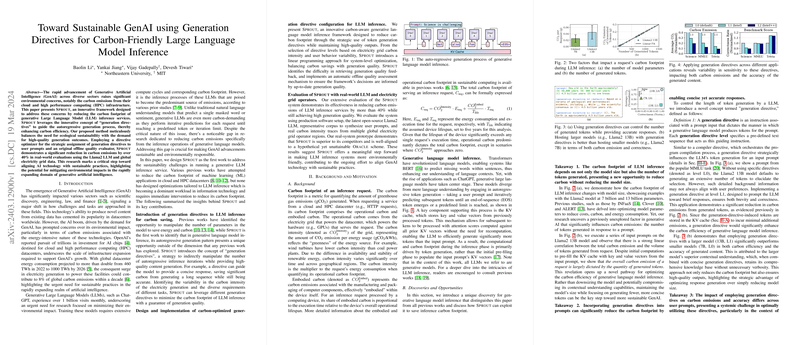Toward Sustainable Generation of AI: Sprout Optimizes Carbon Footprint for LLM Inference
Introduction
The rapid progression of Generative AI (GenAI) technology and its integration into various industries have generated concern over its environmental footprint, particularly the carbon emissions from the extensive use of cloud and high-performance computing (HPC) infrastructure. In response, this paper introduces Sprout, an innovative framework designed to mitigate the carbon emissions of generative LLM inference services without compromising the quality of generated content. Sprout shines a spotlight on a novel concept: generation directives that guide the autoregressive generation process, enhancing carbon efficiency while balancing generation outcomes' quality. This initiative marks a crucial step towards harmonizing AI development with sustainability goals.
Generation Directives: An Innovative Approach
Sprout's core innovation lies in the introduction of generation directives, a unique strategy that indirectly manipulates the number of autoregressive inference iterations to generate high-quality content with reduced carbon output. For example, a directive can advise the model to produce concise responses, thereby saving carbon by avoiding the generation of lengthy sequences. This paper elaborates on how Sprout leverages varied generation directives to minimize LLM inference carbon footprint under the assurance of maintaining content generation quality.
Design and Implementation: A Carbon-aware Framework
Sprout is meticulously designed as a carbon-aware generative LLM inference framework. It revolves around a directive optimizer for strategic assignment of generation directives and incorporates an original offline quality evaluator. This design ensures a balanced approach to reducing carbon emissions while preserving the integrity of generated content. Sprout's effectiveness is highlighted through extensive evaluations, demonstrating over 40% carbon savings in real-world setups using the Llama2 LLM across multiple global electricity grid regions.
Evaluation and Implications
The evaluation of Sprout, utilizing real-world LLMs and electricity grid data, substantiates its capability to significantly lower carbon emissions by more than 40% while still attaining high generation quality. These findings emphasize Sprout's alignment with an ideal yet unattainable Oracle scheme in reducing LLM inference systems' environmental impact. Further, the utility and adaptability of Sprout across various application scenarios promise a sustainable path forward for GenAI, potentially transforming how the AI community addresses environmental concerns linked to AI's expansive growth.
The Road Ahead: Future Developments in Sustainable GenAI
Sprout's introduction of generation directives opens up new avenues for enhancing the environmental sustainability of generative LLMs. Future research can extend Sprout's principles to broader aspects of AI operations, potentially leveraging generation directives to improve LLM inference throughput and minimize infrastructure requirements. Such advancements could not only reduce operational costs but also significantly lower the carbon footprint associated with the deployment of AI technologies, steering the GenAI domain towards a more sustainable future.
Sprout represents a foundational step in acknowledging and addressing the carbon footprint challenges inherent in the rapid expansion of GenAI. Through continued innovation and exploration of sustainable practices, Sprout sets a precedent for future AI research, emphasizing the importance of aligning technological advancements with environmental stewardship.
